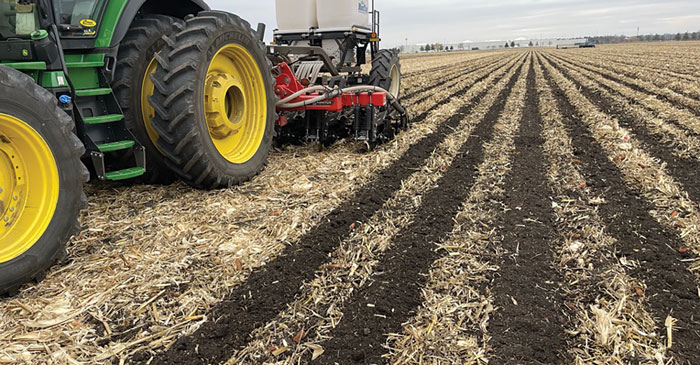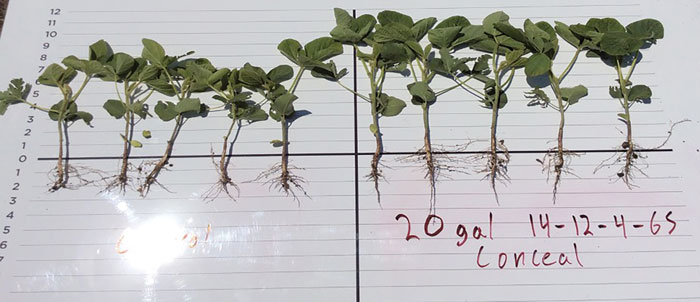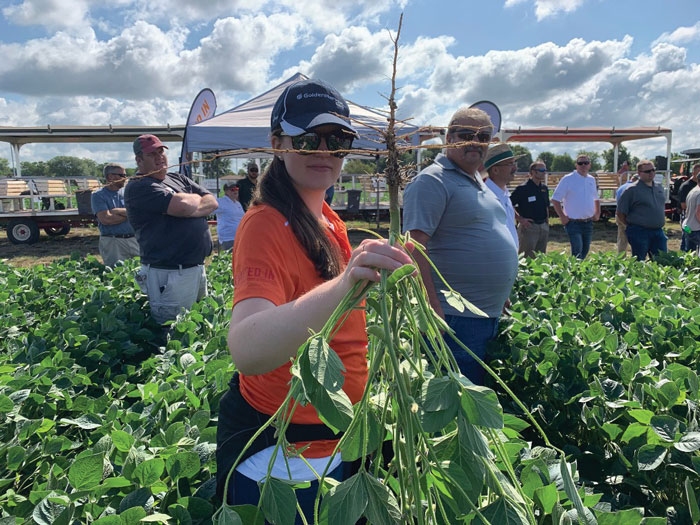As a kid, Jason Webster’s father and grandfather taught him how to farm using conventional tillage, but it didn’t always sit right.
“There were some years I thought, ‘Boy, there’s got to be a better way of doing this,’” Webster says. “When I started farming, I went no-till. I still remember my dad saying, ‘Oh my gosh, you went rogue.’ I wanted to be completely opposite. But I tried to do things differently than what Dad and Grandpa were doing, and I failed at it.”
After the failure, Webster modulated his approach and tried strip-tillage instead.
“I thought, ‘Hey, wait a minute here. I think we’re onto something. I think this might work,’” he says.
36 years later, Webster is still strip-tilling. These days, he works as the lead commercial agronomist for the Precision Technology Institute (PTI) for Precision Planting in Pontiac, Ill. At the PTI’s 400-acre research farm, Webster and his team conduct annual agronomy trials, running 160 trials in 2023 alone. The PTI trials always have two goals: find techniques that offer more yield per acre, and to increase profits.

WIDE STRIPS. Webster opts to make a 10-inch-wide, 8-10-inch-deep strip with his strip-till toolbar. “If I make a strip that’s too narrow, in the spring when I set the planter down, those gauge wheels are going to fall off the strip. You start hitting the throttle on your planter tractor and all of a sudden, your gauge wheels are moving around and your planter performance falls apart.” Photo: Jason Webster/Precision Technology Institute
“When you come to the farm, you’ll hear us talking about challenging the status quo,” Webster says. “Farmers do things a certain way on their farm because they feel comfortable with it. It’s what Dad or Granddad taught them to do. But I wonder if there’s some management that could be better. That’s what our PTI farm is about.”
Strip-Till vs. Other Systems
One PTI study collected 5 years of data looking at how strip-tillage stacks up to conventional tillage, vertical tillage and no-till in terms of yield and economics.
“Every one of these tillage programs has a system cost, which is calculated into this,” Webster says. “With no-till, for example, you’re not burning lots of fuel, but you’re going to have more of a burndown expense.”
Between 2018 and 2021, Webster says the data points to strip-till as the most economical system, with average net returns of $1,023.06 per acre, followed by conventional tillage at $1,004.65 per acre, vertical tillage at $999.34 per acre and no-till in last place at $993.96 per acre.
Strip-Till Lessons Learned at the PTI Farm
In this deep-dive session from the National Strip-Tillage Conference, PTI Farm Manager Jason Webster shares the PTI farm’s 2022 plot results and explains how you can personally apply what his agronomic team has learned from 400-plus acres of research trials. Click here to watch the presentation.
Webster asked several longtime no-tillers why he was seeing low average net returns for the no-till plot. They told him it likely had to do with the plot’s transitional period, as it had been under conventional tillage for 50-60 years prior to no-till.
“They said it would take at least 5 years before the no-till plot’s numbers would start to look good,” Webster says. “And that’s what I’ve got going on in my data because in 2022, even though strip-till was my highest yielder overall, when you put the system cost into this, for the first time on my farm, no-till actually won on a dollar-per-acre basis. It took 5 years to get it there, but it did.”
In 2022, the strip-till plot yielded the highest at 267.4 bushels per acre, but no-till came out on top for overall economics, netting $1,565.40 per acre, followed by strip-till at $1,561.90.
Strip-Till Soybeans ROI
An analysis of the profitability of PTI Farm’s 2022 agronomic studies shows high management strip-till soybeans offered the best ROI at the research farm, bringing in additional revenue of $292.25 per acre.
The beans were strip-tilled in the fall with banded 18-46-0/0-0-60 dry fertilizer. Researchers don’t use anhydrous ammonia because it dictates when they can make the strips.
“It’s Labor Day, and it’s 95 degrees. Can I take my strip-till bar out, make strips and put ammonia on at the same time? No, I can’t do that. Soils are too warm,” Webster says. “Consequently, my strip-till rig sits in the tool shed, and we wait for cooler temperatures. So we just put DAP and potash on the tanks of our strip-till bar, and it works out really well.”

SOYBEAN TRIALS. The soybeans on the left received DAP and potash put down while strip-tilling, a popular program among strip-tillers. The ones on the right received a lower rate of DAP and potash in the strips, but additional fertility at planting. “We can continue to feed soybeans throughout the year,” Webster says. “We don’t have to do it all upfront in the fall on our strip-till. It’s a standard program for us, and it works really nice, especially when you look at soybean fertilizers being pretty salty, and you can’t put them in the furrow. This is safe, and we can get this done effectively.” Photo: Jason Webster/Precision Technology Institute
Some plots are irrigated with 5 inches of water. The irrigation water is retained from drainage tile and moved to Netafim drip tape, some buried and some on top of the soil, when the crop needs it.
Webster says there’s always an “explosion” of root activity in the rows in soybean plots where there is drip tape. The roots can be found throughout the 30-inch rows and sometimes look more like fibrous roots than tap roots, with lateral fibers shooting out to capture moisture.
“We’re almost manipulating the architecture of some of these soybean roots, and I think that’s why we’re pushing yield like we are,” Webster says. “There’s not a year that’s gone by that hasn’t given us at least a 23-bushel yield response on soybeans.”
The soybeans are also treated with Miravis Neo at R1 and Trivapro at R3.
“Going from a 100% rate broadcast to 50% rates in a band makes $52 an acre…”
Strip-till also offers an advantage because the strips are ready to plant into earlier in the spring. Webster says the exposed soil tends to heat earlier, allowing for planting at the end of March or in April. Planting as late as May can mean losses of 15 bushels, according to PTI farm data.
“I’ve got a strip I made in the fall, and I’ll sneak right in in the spring and plant right into that,” Webster says. “It’s got my first round of fertility right there. When the sun’s shining in March and we can warm up a little bit, we get the thermal radiation on that nice black strip.”
Strip-till corn also proved profitable on the PTI Farm in 2022. High-management corn had the second-highest ROI of the agronomy studies at $252.74 per acre.
Banding vs. Broadcasting Nutrients
Re-allocating fertilizer is important to ensure that the crop gets what it needs when it needs it, Webster says. It also saves the farmer dollars. Right after harvest, PTI researchers soil test to get a baseline.
“I know when my planter runs, I’m going to have tanks and pumps on it, and I’m going to put more fertilizer on,” Webster says. “Consequently, I can’t put all of my fertilizer on in the fall in the strips, so I reallocate. I drop that rate of DAP and potash, I trade the dollars, and I end up with a free liquid program on the planter.”
They use Precision Planting’s planter-mounted FurrowJet technology to drop sugars and biologicals in the middle of the strips. FurrowJet “wings” add phosphorus (P) and zinc next to the seed, and Precision Planting’s Conceal technology puts down nitrogen (N), potassium (K), sulfur and boron next to the seed in a dual band.

LATERAL MOVEMENT. A soybean plant with large lateral roots is displayed at the PTI Farm. “That’s where I can feed it, whether it’s with our drip or planter attachments,” Webster says. Photo: Jason Webster/Precision Technology Institute
“We treat the planter as a fertilizer applicator,” Webster says. “I can’t tell you how many farmers say, ‘Jason, I’m not doing this tank and pump thing on a planter. You’re going to slow me down in the spring while I’m trying to run that planter.’ Is that true? It might slow you down, but there’s some dollars on the table.”
In a 10-year corn and soybean study comparing banded fertilizer to broadcast fertilizer, Webster and his team have found that banding almost always makes more sense. Researchers use third-party soil test baselines and recommendations for rates and then apply the full amount on both the broadcast plots and banded plots. Then they compare 75%, 50%, 25% and 0% of the recommended rate.
In the first year of the corn study, plots that received the banded 25% came out $50 per acre ahead of the broadcast plots.
“Farmers do things a certain way because they feel comfortable with it…”
“Let’s go from 100% broadcast to 50% rates in a band,” Webster says. “Now I’m making $52 an acre. Where I got into trouble though, I got a little greedy and reduced it by 75%. I lost $10 per acre. When I shut the gate off and put 0 pounds of fertilizer on, I lost $42 per acre.”
But in the 2nd year of the study, Webster made $40 per acre more on the plots that had no banded fertilizer at all vs. the full rate of broadcast.
“What on earth is happening?” Webster asks. “In soybeans, the same trend is happening. The 0 band beats the broadcast in every single scenario.”
The reason, he says, is some simple math — and the historically high cost of fertilizer.
“The costs are terrible, and you’re forced to get your checkbook out and write a check for this stuff,” Webster says. “In the fall of 2020, I spent $650 for DAP and $115 per ton for potash. 2 years later, I’m near $900 for DAP and $800 for potash. Ladies and gentlemen, this is where we need to flex.”
Webster says no-tillers will still need to buy some fertilizer, but if they’re banding, they only need half as much. In the corn and soybean trials, the 50% rate banded plots were the best-performing plots in both yield and economics.






